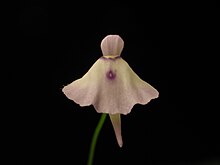Utricularia pubescens
| Utricularia pubescens | |
|---|---|

| |
| Scientific classification | |
| Kingdom: | Plantae |
| Clade: | Tracheophytes |
| Clade: | Angiosperms |
| Clade: | Eudicots |
| Clade: | Asterids |
| Order: | Lamiales |
| Family: | Lentibulariaceae |
| Genus: | Utricularia |
| Subgenus: | Utricularia subg. Bivalvaria |
| Section: | Utricularia sect. Lloydia P.Taylor |
| Species: | U. pubescens
|
| Binomial name | |
| Utricularia pubescens | |
Utricularia pubescens is a small to medium-sized, probably annual, terrestrial or lithophytic carnivorous plant that belongs to the genus Utricularia and is the only member of Utricularia sect. Lloydia. U. pubescens is native to India, tropical Africa, and Central and South America. It was originally published and described by James Edward Smith in 1819 and placed in its own section, Lloydia, by Peter Taylor in 1986. It grows as a terrestrial or lithophytic plant in boggy grasslands in damp peaty soils at altitudes from sea level to 1,900 m (6,234 ft). This species possesses small peltate leaves, which are diagnostic for this species in the genus.[1]

Synonyms
Utricularia pubescens is an extremely variable species and its distribution covers a large native range, two factors that have led to a considerable amount of synonymy.[1]
- [U. capensis Kamieński]
- U. connellii N.E.Br.
- U. deightonii F.E.Lloyd & G.Taylor
- U. fernaldiana F.E.Lloyd & G.Taylor
- [U. firmula Hutch. & Dalziel]
- U. graniticola A.Chev. & Pellegr.
- U. hydrocotyloides F.E.Lloyd & G.Taylor
- [U. nivea Afzel. ex Kamieński]
- U. papillosa Stapf
- [U. pauciflora Afzel. ex Kamieński]
- U. peltata Spruce ex Oliv.
- U. peltatifolia A.Chev. & Pellegr.
- U. puberula Benj.
- U. regnellii Sylvén
- U. sciaphila Tutin
- U. subpeltata Steyerm.
- U. thomasii F.E.Lloyd & G.Taylor
- U. venezuelana Steyerm.
See also
References
- ^ a b Taylor, Peter. (1989). The genus Utricularia - a taxonomic monograph. Kew Bulletin Additional Series XIV: London.
External links
- Utricularia
- Carnivorous plants of Africa
- Carnivorous plants of Asia
- Carnivorous plants of Central America
- Carnivorous plants of South America
- Flora of Angola
- Flora of Brazil
- Flora of Cameroon
- Flora of Colombia
- Flora of Ivory Coast
- Flora of Ethiopia
- Flora of Guinea
- Flora of Guyana
- Flora of the Indian subcontinent
- Flora of Liberia
- Flora of Malawi
- Flora of Nigeria
- Flora of Panama
- Flora of Senegal
- Flora of Sierra Leone
- Flora of Tanzania
- Flora of the Central African Republic
- Flora of the Democratic Republic of the Congo
- Flora of Uganda
- Flora of Venezuela
- Flora of Zambia
- Plants described in 1819
- Lentibulariaceae stubs
